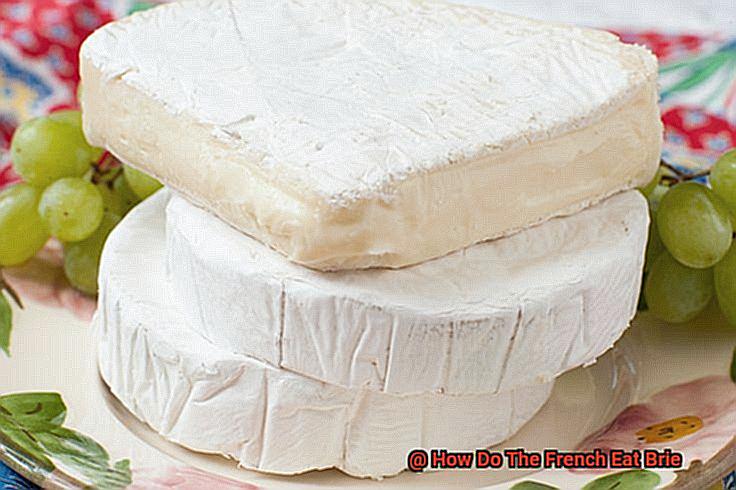France is a nation renowned for its cheese-making prowess and culinary expertise, and Brie is undoubtedly one of the most iconic French cheeses. With its smooth texture, rich buttery flavor, and earthy undertones, Brie has become a timeless classic that can be enjoyed as an appetizer, entrée, or dessert.
But have you ever wondered how the French – the ultimate cheese connoisseurs – eat their Brie? It’s not just a matter of slicing it up and throwing it on a cracker. In fact, there are many ways to savor this famous fromage like a true Parisian.
In this post, we’ll delve into the intricacies of how the French truly enjoy their Brie. We’ll explore various serving suggestions such as pairing it with a crusty baguette and some fine wine or incorporating it into tarts or fondue. We’ll also examine different types of Brie like the classic Brie de Meaux or the indulgent double-cream variety and share tips on how to store and serve it properly.
Whether you’re a Francophile seeking to expand your gastronomic horizons or simply a cheese lover looking for new ways to indulge in cheesy goodness, this post will provide you with all the information you need to savor Brie like a true connoisseur. So buckle up and get ready for an adventure into the art of Brie-eating.
Contents
Serving Brie at Room Temperature

To fully appreciate this French classic, it must be served at room temperature.
Why is room temperature so crucial for serving Brie? Cold Brie cheese loses its characteristic creamy texture and flavor when chilled. To experience the full complexity of the cheese, it’s essential to remove it from the fridge at least an hour before serving. Allowing Brie to warm up to room temperature brings out its natural flavors and aromas, enhancing the overall taste experience.
When serving Brie cheese, having suitable accompaniments is indispensable. Crusty bread, crackers, sliced fruit, or even drizzling honey or balsamic vinegar over the cheese all make excellent pairings. In France, crusty baguettes are the go-to choice for serving alongside Brie cheese. The contrast between the bread’s texture and the cheese’s creaminess makes for a delightful taste sensation.
While some people may prefer to remove the rind of Brie cheese before serving it, the French typically leave it intact. The rind adds another layer of flavor and texture to the cheese that enhances its overall taste experience.
Wine pairing is an essential component of French cuisine, and it’s no different when serving Brie cheese. Light-bodied red wines like Pinot Noir or white wines like Chardonnay pair exceptionally well with Brie. The key is to select a wine that won’t overpower the delicate flavors of the cheese.
Finally, when it comes to serving options, there are many possibilities. Fresh fruit or charcuterie (cured meats) can round out a cheese board that can be enjoyed as a meal or appetizer.
Pairing Brie with Bread and Wine
Brie cheese, with its soft and luscious texture, is a beloved French cheese that never fails to impress. But why settle for just its delicious flavor when you can combine it with bread and wine for a heavenly gastronomic experience? Pairing brie with bread and wine is a classic French tradition that elevates the taste of this cheese to new heights.
When it comes to choosing the right bread, the French have got it down pat. A baguette or a crusty country-style loaf is the perfect match for brie. To bring out the bread’s full flavor, it should be slightly toasted or warmed before serving. A baguette is an ideal option for serving slices of brie, while a country-style loaf is better for serving larger chunks.
Pairing wine with cheese is an art form that the French have mastered. For brie, a light-bodied red wine such as Pinot Noir or Beaujolais works like magic. These wines have enough acidity to cut through the richness of the brie without overpowering its delicate flavors. If red wine isn’t your thing, try pairing your brie with a dry white wine such as Chardonnay or Sauvignon Blanc.
To fully appreciate the pairing experience, it’s crucial to let the cheese come to room temperature before serving. This allows the flavors to fully develop and makes for a more enjoyable experience. Cut the brie into small wedges or slices and arrange them on a platter alongside the bread and wine.
Now comes the best part – savoring each bite. Take a slice of bread, followed by a slice of brie, and then sip some wine. The combination of flavors should be well-balanced, with the bread providing a crunch and texture, the brie offering creaminess and richness, and the wine cutting through it all with acidity.
Accompanying Brie with Other Foods
Let’s explore the world of Brie pairings and take your taste buds on a journey they won’t forget.
Let’s begin with a classic French Brie pairing: baguette slices and grapes. This combination is sweet and tangy, with the sweetness of the grapes perfectly complementing the mild flavor of the cheese. The crusty bread adds an extra layer of texture to this heavenly pairing.
If you’re feeling a bit adventurous, try pairing Brie with walnuts. The nuttiness of the walnuts complements the creamy texture of the cheese, creating a delightful indulgence for your taste buds. For a sweet and savory combination, try dried fruit like apricots or figs.
For those who prefer more savory pairings, cured meats like prosciutto or salami are the perfect match for Brie. The saltiness of the meat balances out the creaminess of the cheese, creating an addictive flavor that you won’t be able to resist.
For a more elevated pairing, add some honey or jam to your Brie. The sweetness of these spreads complements the mild flavor of the cheese and adds an extra layer of complexity to the pairing. Trust me; this combination will take your taste buds on a journey they won’t forget.
Brie can even be incorporated into your main course. Top your salad with sliced Brie or serve it alongside roasted vegetables for a more substantial meal. You can also melt it beautifully for grilled sandwiches or as a topping for burgers.
Eating the Rind of the Cheese
Well, as an expert on the topic, I’m here to provide you with everything you need to know about eating the rind of Brie cheese.
Let’s start with the basics. The rind of Brie cheese is indeed edible and can add a unique and delicious flavor and texture to your cheese experience. However, it’s important to note that not all rinds are created equal. So how do you determine if the rind is worth eating?
One simple way to test the rind is by giving it a whiff. If it smells musty or like ammonia, it may not be enjoyable to eat. But if it smells earthy or like mushrooms, then it’s definitely worth a try.
Now onto the fun part: how to enjoy the rind of Brie cheese. There are two main methods: including the rind when slicing the cheese or removing the creamy interior and leaving the rind behind.
If you choose to include the rind, simply slice a piece of Brie with a knife, including both the creamy interior and the rind, and place it on a cracker or bread. Some people prefer to remove the very outer layer of the rind before eating, especially if it’s particularly thick or tough.
On the other hand, if you want to savor just the creamy center, slice off the top layer of the cheese using a knife or spoon. Then scoop out the luscious center with a cracker or bread and leave behind the rind.
But what makes Brie’s rind so special? The rind of Brie is actually formed by a type of mold that helps break down and ripen the cheese from the outside in. This process results in a unique flavor that complements the creamy interior perfectly.
In fact, when it comes to eating Brie like the French do, it’s customary to embrace the entire cheese, including the rind. So why not give it a try? You may discover a new favorite way to enjoy Brie cheese.
Enjoying Brie Like the French
To start, selecting a high-quality Brie is crucial. Opt for a cheese made with premium milk, creamy texture, and mild flavor for a taste experience like no other.
When serving Brie, temperature is key. The French know that room temperature provides the perfect balance of texture and flavor. Take it out of the fridge at least an hour before serving to enhance its taste.
There are endless ways to serve Brie like the French do. Pair it with crackers or sliced baguette, or add fresh fruit like grapes or figs for a sweet twist. For an authentic experience, include it as part of a cheese board with other types of cheeses and pair it with nuts, honey or dried fruits.
Eating Brie requires some etiquette too. It’s best to cut small wedges or slices to appreciate its creamy texture fully. Spread it onto bread or crackers to balance out the richness of this cheese and make every bite more satisfying.
Tips on Selecting Quality Brie
Brie cheese is a soft and creamy cheese that is loved by many. However, not all Brie cheese is created equal. To ensure that you’re selecting high-quality Brie, here are some tips to keep in mind:
Choose Authentic French Brie
When it comes to Brie cheese, France is the birthplace of this delicious cheese. Authentic French Brie is made with raw milk and has a unique flavor and texture that sets it apart from imitations made with pasteurized milk. If you want to experience the real taste of Brie, look for cheese that is made in France.
Consider the Age of the Cheese
Like wine, Brie cheese can be enjoyed at different stages of ripeness, each with its unique flavor profile. Younger Brie cheese will have a milder flavor and firmer texture, while older cheese will be more complex and creamy. If you prefer a particular taste, look for younger or older Brie cheese to suit your preference.
Pay Attention to Appearance and Texture
When selecting Brie cheese, pay attention to its appearance and texture. Look for cheese that has a soft and creamy texture and a rind that is free of cracks or mold. The rind protects the cheese and helps it develop its distinctive flavor, so it’s important to choose Brie with a healthy rind. The cheese should also have a slightly sweet, nutty aroma that is indicative of good quality.
Store Properly
Brie cheese can be quite perishable, so it’s essential to store it properly to prevent spoilage. Keep the cheese refrigerated at all times, and wrap it tightly in plastic wrap or parchment paper to prevent it from drying out or absorbing unwanted odors from other foods in the fridge.
Let it Come to Room Temperature Before Serving
Brie cheese is traditionally served at room temperature. Before serving, take the Brie out of the refrigerator at least an hour before to allow the cheese to fully develop its flavors and textures. Savor each bite and pair it with complementary flavors and textures for the ultimate culinary experience.
Consider the Source
To ensure that you’re getting high-quality Brie cheese, look for cheese that comes from reputable producers who use high-quality milk and traditional methods of production. You can often find information about the producer on the label or by doing some research online.
Storing Brie Properly
Brie cheese is a French delicacy that requires proper storage to fully appreciate its creamy texture and delicious flavor. As an expert in the world of cheese, I can attest that storing Brie correctly is essential to maintain its quality and freshness. Here are some tips to help you store your Brie properly and enjoy it for as long as possible.
Firstly, Brie is a soft cheese that needs to be kept in the fridge, but not in the coldest part as it can cause the cheese to harden. Instead, store it in the warmer section of the fridge, like the vegetable drawer or on the top shelf. This will help preserve its soft texture and rich flavor.
Secondly, wrap your Brie in its original packaging or wax paper or parchment paper. This will prevent it from drying out and developing a hard rind. If you don’t have either, plastic wrap is an alternative, but avoid wrapping it too tightly as this can also dry out the cheese.
Thirdly, keep your Brie away from strong-smelling foods as it can easily absorb these odors. Store it in a separate compartment or container to avoid any unwanted smells.
Lastly, if you have leftover Brie, wrap it up tightly in wax paper or plastic wrap and store it in the fridge. However, remember that Brie has a limited shelf life and should be consumed within a few days of opening.
Health Benefits of Eating Brie
Look no further than brie cheese. Originating from France, brie cheese is a soft-ripened cheese made from cow’s milk and has a mild flavor and creamy texture that pairs perfectly with crackers, bread, or even fruit. But did you know that brie cheese also has several health benefits?
Firstly, brie cheese is an excellent source of calcium. This essential nutrient is crucial for building and maintaining strong bones and teeth, as well as for muscle function and nerve transmission. A 1-ounce serving of brie cheese contains about 5% of the recommended daily intake for adults, making it a great option for those looking to boost their calcium levels.
In addition to calcium, brie cheese also contains vitamin B12, an essential vitamin for healthy red blood cells and proper nerve function. Vitamin B12 is primarily found in animal products, which makes brie cheese an excellent source of this nutrient for vegetarians. A 1-ounce serving of brie cheese contains about 20% of the recommended daily intake for adults.
But that’s not all – brie cheese also contains probiotics. Probiotics are live microorganisms that can help improve gut health and boost the immune system. Brie cheese contains lactic acid bacteria, which are probiotics that can keep your digestive system healthy.
Last but not least, brie cheese is also a great source of protein. Protein is essential for building and repairing tissues in the body, as well as maintaining healthy skin, hair, and nails. A 1-ounce serving of brie cheese contains about 10% of the recommended daily intake for adults.
Conclusion
In conclusion, enjoying Brie like the French is not just about satisfying your hunger but creating an unforgettable experience. The secret to savoring this iconic cheese lies in serving it at room temperature and pairing it with complementary flavors and textures. Whether you opt for crusty bread, fresh fruit, or cured meats, there are endless ways to appreciate the creamy texture and rich flavor of Brie.
To truly relish the taste of Brie, selecting high-quality cheese made with premium milk and traditional production methods is crucial. Additionally, proper storage is essential to ensure its quality and freshness. Keep it wrapped tightly in wax paper or parchment paper in the warmer section of your fridge.
Brie cheese isn’t just delicious; it also has several health benefits. It’s an excellent source of calcium, vitamin B12, probiotics, and protein. So indulging in cheesy goodness not only satisfies your cravings but also nourishes your body.
In summary, whether you’re a Francophile seeking new gastronomic experiences or a cheese lover looking for new ways to indulge in cheesy goodness, savoring Brie like a true connoisseur requires attention to detail and appreciation for its complexity of flavor. So why not treat yourself to some authentic French Brie today?






